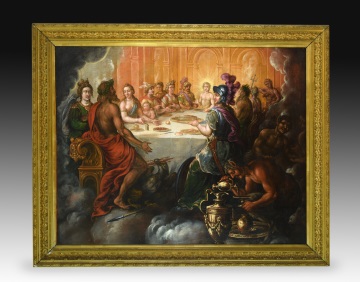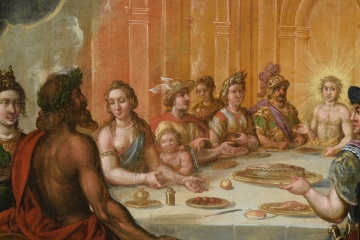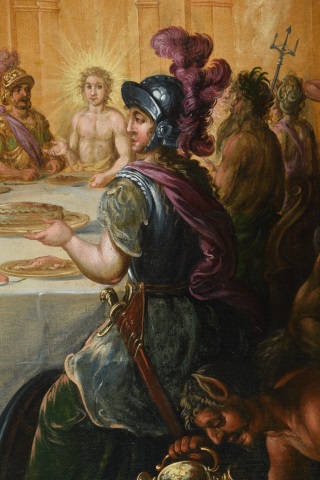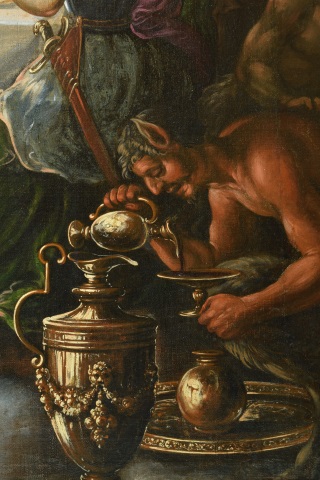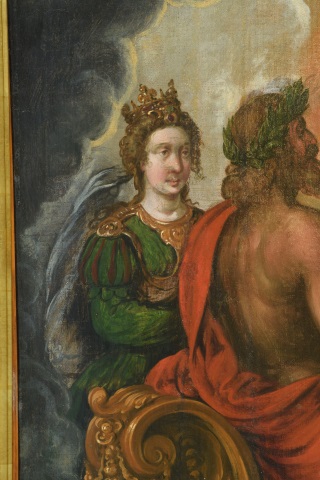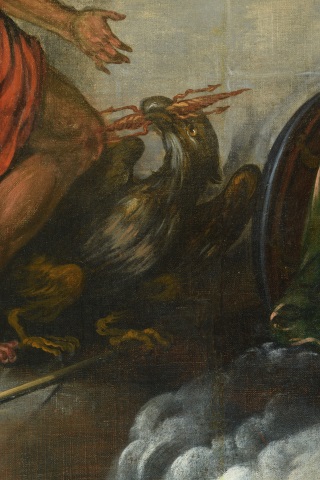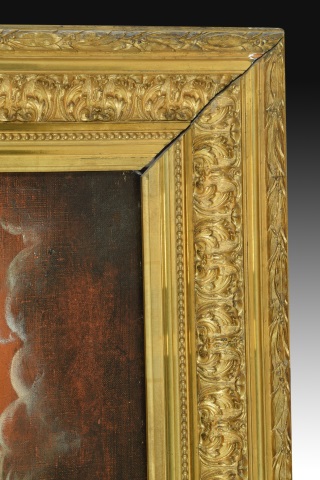OIL ON CANVAS MARRIAGE THETIS AND PELEUS
Antiques - PaintingsReference: Z6297
Madrid school of the 17th century. Circle of CORTE, Juan de la (Antwerp, c. 1585 – Madrid, 1662). “The Wedding of Thetis and Peleus”. Oil on canvas. This work describes the wedding of the Nereid Thetis and Prince Peleus, parents of Achilles. It was celebrated on Mount Pelion, and all the deities attended, although Eris, the goddess of discord, was not invited. In revenge, she threw a golden apple on which was written "for the most beautiful", which caused the dispute between Athena, Aphrodite and Hera that led to the Judgement of Paris, and finally caused the Trojan War. The banquet is depicted in a highly worked composition, set in a rich interior of classical architecture illuminated by the light of Apollo, who is situated at the farthest end from the viewer. At the head of the table, in the foreground, appears Zeus, accompanied by the eagle and with Hera, queen of the gods, to his left. In the lower right corner we see a group of satyrs serving wine, accompanied by rich metal vessels worked with a meticulous and descriptive brushstroke. The rest of the gods appear clearly differentiated, with Athena in the foreground on the right and, following an agile zigzag rhythm, typically baroque, Aphrodite with Eros, Hermes and the bride and groom, on the left, and Poseidon on the right. Formally, this is a work perfectly framed within the 17th century Madrid school, developed around the court. Thus, we see a sumptuous, allegorical classicist baroque, where the studies of light and colour take on special relevance, revealing the exalted and luminous tone typical of the maturity of this school. Specifically, we can relate this painting to the circle of Juan de la Corte, a painter of Flemish origin. Nothing is known today about his early training, since Palomino's claim that he was born in Spain was refuted by documents, citing in his will that he was born in Antwerp. Documents are also preserved in which the painter declares his apprenticeship in Flanders, where he “practiced his trade for many years”. For all these reasons, he has been related to Flemish artists of the time who, due to personal knowledge or the study of their works, strongly influenced the configuration of his personal language. We know of his establishment in Spain at least since 1613. His work at court encouraged him to apply for the position of royal painter left vacant by Bartolomé González in 1627, an objective which he did not achieve. There is no documentary evidence, therefore, to support Palomino's claim that he was the king's painter. However, he enjoyed moderate success in the capital of the kingdom, with his works being found in numerous noble inventories of the time. At the same time, he received royal commissions, such as the cycle of biblical stories that he painted for the Buen Retiro palace. His activity, according to his own confession, focused on "architectures, battles and countries", genres in which he was highly valued by his contemporaries. One of the most interesting characteristics of his style is the fact that he frequently dealt with mythological themes which, brought to the canvas in different cycles, offer us a singularly majestic panorama of a theme that was not very common in the painting of Spain at the time. Another of the outstanding aspects of his work was the proliferation of architectural perspectives clearly linked to Nordic writers, among whom Vredeman de Vries stands out in particular. His pictorial style remained anchored in earlier traditions, demonstrating an evident modesty and archaism, but the uniqueness of the subjects he dealt with makes him worthy of remembrance. Juan de la Corte is represented in the Museo del Prado, the Marítimo in Barcelona, the Cerralbo and the Municipal in Madrid, among others.
· Size: 97 x 122 cm; 116 x 143 cm (marco).









